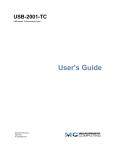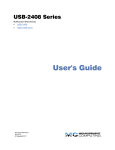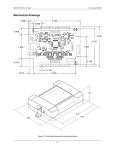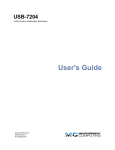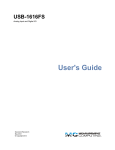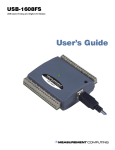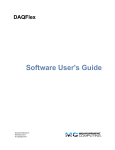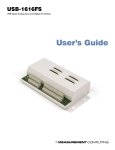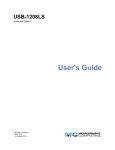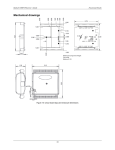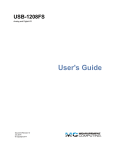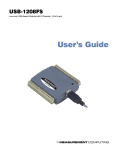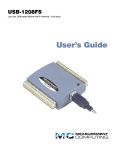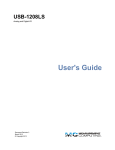Download USB-1608FS-Plus User's Guide
Transcript
USB-1608FS-Plus Analog Input and Digital I/O User's Guide Document Revision 3 October 2013 © Copyright 2013 Your new Measurement Computing product comes with a fantastic extra — Management committed to your satisfaction! Thank you for choosing a Measurement Computing product—and congratulations! You own the finest, and you can now enjoy the protection of the most comprehensive warranties and unmatched phone tech support. It’s the embodiment of our mission: To provide data acquisition hardware and software that will save time and save money. Simple installations minimize the time between setting up your system and actually making measurements. We offer quick and simple access to outstanding live FREE technical support to help integrate MCC products into a DAQ system. Limited Lifetime Warranty: Most MCC products are covered by a limited lifetime warranty against defects in materials or workmanship for the life of the product, to the original purchaser, unless otherwise noted. Any products found to be defective in material or workmanship will be repaired, replaced with same or similar device, or refunded at MCC’s discretion. For specific information, please refer to the terms and conditions of sale. Harsh Environment Program: Any Measurement Computing product that is damaged due to misuse, or any reason, may be eligible for replacement with the same or similar device for 50% of the current list price. I/O boards face some harsh environments, some harsher than the boards are designed to withstand. Contact MCC to determine your product’s eligibility for this program. 30 Day Money-Back Guarantee: Any Measurement Computing Corporation product may be returned within 30 days of purchase for a full refund of the price paid for the product being returned. If you are not satisfied, or chose the wrong product by mistake, you do not have to keep it. These warranties are in lieu of all other warranties, expressed or implied, including any implied warranty of merchantability or fitness for a particular application. The remedies provided herein are the buyer’s sole and exclusive remedies. Neither Measurement Computing Corporation, nor its employees shall be liable for any direct or indirect, special, incidental or consequential damage arising from the use of its products, even if Measurement Computing Corporation has been notified in advance of the possibility of such damages. Trademark and Copyright Information Measurement Computing Corporation, InstaCal, Universal Library, and the Measurement Computing logo are either trademarks or registered trademarks of Measurement Computing Corporation. Refer to the Copyrights & Trademarks section on mccdaq.com/legal for more information about Measurement Computing trademarks. Other product and company names mentioned herein are trademarks or trade names of their respective companies. © 2013 Measurement Computing Corporation. All rights reserved. No part of this publication may be reproduced, stored in a retrieval system, or transmitted, in any form by any means, electronic, mechanical, by photocopying, recording, or otherwise without the prior written permission of Measurement Computing Corporation. Notice Measurement Computing Corporation does not authorize any Measurement Computing Corporation product for use in life support systems and/or devices without prior written consent from Measurement Computing Corporation. Life support devices/systems are devices or systems that, a) are intended for surgical implantation into the body, or b) support or sustain life and whose failure to perform can be reasonably expected to result in injury. Measurement Computing Corporation products are not designed with the components required, and are not subject to the testing required to ensure a level of reliability suitable for the treatment and diagnosis of people. HM USB-1608FS-Plus Table of Contents Preface About this User's Guide ....................................................................................................................... 5 What you will learn from this user's guide ......................................................................................................... 5 Conventions in this user's guide ......................................................................................................................... 5 Where to find more information ......................................................................................................................... 5 Chapter 1 Introducing the USB-1608FS-Plus ....................................................................................................... 6 Functional block diagram ................................................................................................................................... 6 Chapter 2 Installing a USB-1608FS-Plus .............................................................................................................. 7 What comes with your shipment? ....................................................................................................................... 7 Hardware .......................................................................................................................................................................... 7 Software ............................................................................................................................................................................ 7 Documentation .................................................................................................................................................................. 7 Unpacking........................................................................................................................................................... 7 Installing the software ........................................................................................................................................ 7 DAQFlex .......................................................................................................................................................................... 7 Universal Library and InstaCal ......................................................................................................................................... 8 Installing the hardware ....................................................................................................................................... 8 Calibrating the hardware..................................................................................................................................... 8 Chapter 3 Functional Details ................................................................................................................................. 9 Analog input modes ............................................................................................................................................ 9 Software paced .................................................................................................................................................................. 9 Hardware paced ................................................................................................................................................................ 9 Burst scan ......................................................................................................................................................................... 9 External components .......................................................................................................................................... 9 USB connector .................................................................................................................................................................10 LED .................................................................................................................................................................................10 Screw terminals................................................................................................................................................................10 Signal connections ............................................................................................................................................ 11 Analog input ....................................................................................................................................................................11 Digital I/O ........................................................................................................................................................................12 Counter input ...................................................................................................................................................................13 SYNC I/O ........................................................................................................................................................................13 Trigger input ....................................................................................................................................................................13 Reserved ..........................................................................................................................................................................13 Ground .............................................................................................................................................................................13 Power output ....................................................................................................................................................................13 Accuracy ........................................................................................................................................................... 13 Synchronized operations................................................................................................................................... 15 Mechanical drawings ........................................................................................................................................ 16 Chapter 4 Specifications ...................................................................................................................................... 17 Analog input ..................................................................................................................................................... 17 Accuracy ........................................................................................................................................................... 17 Analog input DC voltage measurement accuracy ............................................................................................................17 Noise performance ...........................................................................................................................................................18 Digital input/output........................................................................................................................................... 18 External trigger ................................................................................................................................................. 19 3 USB-1608FS-Plus User's Guide External clock input/output............................................................................................................................... 19 Counter section ................................................................................................................................................. 20 Memory ............................................................................................................................................................ 20 Microcontroller ................................................................................................................................................. 20 Power ................................................................................................................................................................ 21 General ............................................................................................................................................................. 21 Environmental .................................................................................................................................................. 21 Mechanical ....................................................................................................................................................... 21 Screw terminal connector and pinout ............................................................................................................... 22 Declaration of Conformity .................................................................................................................. 23 4 Preface About this User's Guide What you will learn from this user's guide This user's guide describes the Measurement Computing USB-1608FS-Plus data acquisition device and lists device specifications. Conventions in this user's guide For more information Text presented in a box signifies additional information and helpful hints related to the subject matter you are reading. Caution! Shaded caution statements present information to help you avoid injuring yourself and others, damaging your hardware, or losing your data. bold text Bold text is used for the names of objects on a screen, such as buttons, text boxes, and check boxes. italic text Italic text is used for the names of manuals and help topic titles, and to emphasize a word or phrase. Where to find more information Additional information about the USB-1608FS-Plus is available on our website at www.mccdaq.com. You can also contact Measurement Computing Corporation by phone, fax, or email with specific questions. Knowledgebase: kb.mccdaq.com Phone: 508-946-5100 and follow the instructions for reaching Tech Support Fax: 508-946-9500 to the attention of Tech Support Email: [email protected] 5 Chapter 1 Introducing the USB-1608FS-Plus The USB-1608FS-Plus is an analog input and digital I/O data acquisition device providing the following features: Eight 16-bit single-ended (SE) analog input channels Each input channel has a dedicated A/D converter for simultaneous sampling. Software-selectable analog input ranges of ±10 V, ±5 V, ±2 V, and ±1 V Eight individually configurable digital I/O channels One 32-bit event counter One external digital trigger input Bidirectional external clock for synchronous operation with more than one device. Screw terminals for field wiring connections The device is powered by the +5V USB supply from the computer, requiring no external power. The USB-1608FS-Plus is compatible with both USB 1.1 and USB 2.0 ports. The speed of the device may be limited when using a USB 1.1 port due to the difference in transfer rates on the USB 1.1 versions of the protocol (low-speed and full-speed). Functional block diagram USB-1608FS-Plus functions are illustrated in the block diagram shown here. Figure 1. Functional block diagram 6 Chapter 2 Installing a USB-1608FS-Plus What comes with your shipment? Verify that the following hardware components are included in the shipment: Hardware USB-1608FS-Plus USB cable Software MCC DAQ CD Documentation MCC DAQ Quick Start Guide The Quick Start Guide booklet provides an overview of the MCC DAQ software you received with the device, and includes information about installing the software. Please read this booklet completely before installing any software or hardware. DAQFlex Insert The DAQFlex insert ships with all hardware that supports DAQFlex software. The operating systems supported by the device are listed on the insert, and includes the internet location where you can download DAQFlex software, and the locations where you can learn more about DAQFlex software and MCC DAQ software. Unpacking As with any electronic device, take care while handling to avoid damage from static electricity. Before removing the USB-1608FS-Plus from its packaging, ground yourself using a wrist strap or touch either the computer chassis or other grounded object to eliminate any stored static charge. If the device is damaged, notify Measurement Computing Corporation immediately by phone, fax, or email. Knowledgebase: kb.mccdaq.com Phone: 508-946-5100 and follow the instructions for reaching Tech Support Fax: 508-946-9500 to the attention of Tech Support Email: [email protected] For international customers, contact your local distributor. Refer to the International Distributors section on our web site at www.mccdaq.com/International. Installing the software Note: Before installing the USB-1608FS-Plus, first install the software you plan to use with the device. The USB-1608FS-Plus is supported by Universal Library software and DAQFlex software. You can install both software packages on your computer. However, you cannot run both software packages simultaneously with one USB-1608FS-Plus device. DAQFlex Install DAQFlex software when you want to develop data acquisition applications that can be deployed across multiple operating systems and custom embedded systems. 7 USB-1608FS-Plus User's Guide Installing a USB-1608FS-Plus DAQFlex software for each supported operating system is available from the DAQFlex download page at www.mccdaq.com/DAQFlexDL. Refer to the DAQFlex Software User's Guide at www.mccdaq.com/pdfs/manuals/DAQFlex%20Software.pdf for instructions about installing DAQFlex software. Universal Library and InstaCal Install Universal Library and InstaCal when you want to develop data acquisition applications using Windows programming languages. Universal Library and InstaCal software are included on the CD that ships with the device. Refer to the Quick Start Guide booklet for instructions about installing Universal Library and InstaCal software. Installing the hardware Install the software before you install your device The driver needed to run the USB-1608FS-Plus device is installed when you install the software. Therefore, you need to install the software package you plan to use before you install the hardware. For operation on a Windows operating system, we recommend that you run Windows Update to update your operating system with the latest USB drivers. To connect the USB-1608FS-Plus to your system, connect the USB cable to an available USB port on the computer or to an external USB hub connected to the computer. Connect the other end of the USB cable to the USB connector on the device. No external power is required. When connected for the first time, a Found New Hardware dialog opens when the operating system detects the device. When the dialog closes, the installation is complete. The LED on the USB-1608FS-Plus turns on after the device is successfully installed. If the LED turns off If communication is lost between the device and the computer, the device LED turns off. To restore communication, disconnect the USB cable from the computer and then reconnect it. This should restore communication, and the LED should turn on. Calibrating the hardware The Measurement Computing Manufacturing Test department performs the initial factory calibration. Return the device to Measurement Computing Corporation when calibration is required. The recommended calibration interval is one year. The USB-1608FS-Plus does not support field calibration. 8 Chapter 3 Functional Details Analog input modes The USB-1608FS-Plus can acquire analog input data in three modes – software paced, hardware paced, and burst scan. Software paced You can acquire one analog sample at a time in software paced mode. You initiate the A/D conversion by calling a software command. The analog value is converted to digital data and returned to the computer. You can repeat this procedure until you have the total number of samples that you want from one channel. The typical throughput sample rate in software paced mode is 500 S/s (system-dependent). Hardware paced You can acquire data from up to eight channels simultaneously in hardware paced mode. The analog data is continuously acquired, converted to digital values, and written to an on-board FIFO buffer on the device until you stop the scan. The FIFO buffer is serviced in blocks as the data is transferred from the device FIFO buffer to the memory buffer on your computer. Data is transferred in blocks from the device to the memory buffer on your computer. The maximum sampling rate is an aggregate rate. The total sample rate using hardware paced mode is 400 kS/s divided by the number of channels, with a maximum rate of 100 kS/s for any channel. You can acquire data from one to four channels at 100 kS/s each, six channels at 66.7 kS/s each, and so on, up to eight channels at 50 kS/s each. You can start a hardware paced scan with a software command or an external hardware trigger event. Burst scan In burst scan mode (BURSTIO), you can acquire data from the USB-1608FS-Plus using the full capacity of the 32 k sample FIFO. The acquired data is read from the FIFO and transferred to a user buffer in the computer. You can initiate a single acquisition sequence of one to eight channels with either a software command or an external hardware trigger event. Burst scans are limited to the depth of the on-board memory, as the data is acquired at a rate faster than it can be transferred to the computer. The maximum sampling rate is an aggregate rate. The total sample rate using burst scan mode is 100 kS/s per channel for any or all channels. A data overrun may occur if you exceed the FIFO capacity and sample >32,768 samples. External components The USB-1608FS-Plus has the following external components, as shown in Figure 2. Screw terminals LED USB connector 9 USB-1608FS-Plus User's Guide 1 2 Functional Details Screw terminal pins 21 to 40 LED 3 4 Screw terminal pins 1 to 20 USB connector Figure 2. USB-1608FS-Plus components USB connector Receives the supplied USB cable. When connected to a computer or USB hub, the cable provides +5 V power and communication. No external power supply is required. LED The LED indicates the communication status; it cannot be disabled. LED behavior LED state Indication On – steady green Blinks once Blinks continuously The device is connected to a computer or external USB hub. A USB command is received. An analog input scan is in progress. Screw terminals The screw terminals provide the following connections: Eight analog inputs (CH0 IN to CH7 IN) Eight digital I/O lines(DIO0 to DIO7) One external event counter input (CTR) One SYNC I/O terminal for external clocking and multi-unit synchronization (SYNC) One external trigger input (TRIG_IN) One power output (PC+5 V) 11 analog ground (AGND) and eight digital ground (GND) connections Use 16 AWG to 30 AWG wire when making connections to the screw terminals. Pinout locations are shown in Figure 3. 10 USB-1608FS-Plus User's Guide Functional Details Figure 3. Screw terminal pinout Signal connections Analog input You can connect up to eight analog input connections to the screw terminal containing pins 1 to 20 (CH0 IN through CH7 IN.) Connect unused analog input terminals to ground terminals during operation. For example, if you are not using terminal 15 (CH7 IN), connect this terminal to terminal 16 (AGND). All analog input channels are configured for single-ended input mode. All analog input signals are referenced to ground (AGND): Connect the wire carrying the signal to be measured to CH# IN. Connect the second wire to AGND. The input voltage ranges are ±10 V, ±5 V, ±2.0 V, ±1.0 V. For more information on analog signal connections For more information on single-ended inputs, refer to the Guide to Signal Connections (this document is available on our web site at www.mccdaq.com/signals/signals.pdf). Channel-Gain queue The channel-gain queue feature allows you to configure a different gain setting for each channel. The gain settings are stored in a channel-gain queue list that is written to local memory on the device. The channel-gain queue list can contain up to eight unique elements. The channel list must be in increasing order. An example of a five element list is shown in the table below. Sample channel-gain queue list Element Channel Range 0 1 2 3 4 CH0 CH2 CH4 CH6 CH7 BIP1V BIP2V BIP10V BIP1V BIP5V 11 USB-1608FS-Plus User's Guide Functional Details Carefully match the gain to the expected voltage range on the associated channel or an over range condition may occur. Although this condition does not damage the device, it does produce a useless full-scale reading, and can introduce a long recovery time due to saturation of the input channel. Digital I/O You can connect up to eight digital I/O lines to DIO0 through DIO7. Each digital channel is individually configurable for input or output. During initial power on or reset the digital pins are set for input. The digital I/O terminals can detect the state of any TTL-level input. Refer to the schematic shown in Figure 4. Figure 4. Schematic showing switch detection by digital channel DIO0 If you set the switch to the +5 V input, DIO0 reads TRUE (1). When set to GND, DIO0 reads FALSE (0). Pull-up/down configuration All digital I/O lines are pulled up to USB +5V (HI) with a 47 kΩ resistor (default). You can change the pull-up/down configuration using the internal jumper labeled DIO. You must remove the device housing to access the jumper on the circuit board. To set the jumper for pull-up or pull-down, complete the following steps. 1. Unplug the device from the computer. 2. Turn the device over and rest the top of the housing on a flat, stable surface. Caution! The discharge of static electricity can damage some electronic components. Before removing the USB-1608FS-Plus from its housing, ground yourself using a wrist strap or touch the computer chassis or other grounded object to eliminate any stored static charge. 3. Remove the three screws from the bottom of the device using a #1 Philips head screwdriver. 4. Hold both the top and bottom sections together, turn the device over and rest it on the surface, then carefully remove the top section of the case to expose the circuit board. Figure 5 shows the location of the DIO jumper on the circuit board. Figure 5. Pull-up/down jumper location 5. Configure the jumper for pull-up or pull-down, as shown in Figure 6. Figure 6. Pull-up/down jumper configuration 12 USB-1608FS-Plus User's Guide 6. Functional Details Replace the top section of the housing, and fasten it to the bottom section with the three screws. For more information on digital signal connections For general information regarding digital signal connections and digital I/O techniques, refer to the Guide to Signal Connections (available on our web site at www.mccdaq.com/signals/signals.pdf). Counter input The CTR terminal is a 32-bit event counter that can accept frequency inputs up to 1 MHz. The internal counter increments when the TTL levels transition from low to high. SYNC I/O The SYNC terminal is a bidirectional I/O signal that can be configured as an input (default) or an output. Configure as an external clock input to pace the A/D conversions from an external source. The SYNC terminal supports TTL-level input signals of up to 100 kHz. Configure as an output that may be used to pace conversions on a second device and acquire data from 16 channels. Refer to page 15 for more information about synchronized operations. Trigger input The TRIG_IN terminal is an external digital trigger input. The trigger mode is software-selectable for edge or level sensitive. Edge sensitive mode is selectable for rising or falling. Level sensitive mode is selectable for high or low. Reserved The RSVD terminal is reserved for future use. Ground The analog ground (AGND) terminals provide a common ground for all analog channels. The digital ground (GND) terminals provide a common ground for the digital, trigger, counter, and sync channels and the power terminal. Power output The PC +5V output terminal can output up to 200 mA maximum. You can use this terminal to supply power to external devices or circuitry. Caution! The PC +5V terminal is an output. Do not connect it to an external power supply or you may damage the device and possibly the computer. The maximum output current that can be drawn by the USB-1608FS-Plus is 500 mA. This maximum applies to most personal computers and self-powered USB hubs. Bus-powered hubs and notebook computers may limit the maximum available output current to 100 mA. If the current requirement of the device exceeds the current available from the computer, connect to a self-powered hub or power the computer with an external power adapter. When running applications with the device, each DIO bit can source up to 24 mA. The total amount of current that can be sourced from the PC +5V, SYNC, and digital outputs is 200 mA max. Accuracy The overall accuracy of any instrument is limited by the error components within the system. Resolution is often used incorrectly to quantify the performance of a measurement product. While "16-bits" or "1 part in 65,536" does indicate what can be resolved, it provides little insight into the quality, or accuracy, of an absolute measurement. Accuracy specifications describe the actual measurement achievable with a USB-1608FS-Plus. Accuracy specifications are listed on page 17. 13 USB-1608FS-Plus User's Guide Functional Details There are three types of errors which affect the accuracy of a measurement system: offset gain nonlinearity The primary error sources in a USB-1608FS-Plus are offset and gain. Nonlinearity is small, and is not significant as an error source with respect to offset and gain. Figure 7 shows an ideal, error-free transfer function. The typical calibrated accuracy of a USB-1608FS-Plus is range-dependent. We use a ±10 V range as an example of what you can expect when performing a measurement in this range. Figure 7. Ideal ADC transfer function The offset error is measured at mid-scale. Ideally, a zero volt input should produce an output code of 32,768. Any deviation from this is an offset error. Figure 8 shows the transfer function with an offset error. The typical offset error specification for a USB-1608FS-Plus on the ±10 V range is ±1.66 mV. Offset error affects all codes equally by shifting the entire transfer function up or down along the input voltage axis. The accuracy plots in Figure 8 are drawn for clarity and are not drawn to scale. Figure 8. ADC transfer function with offset error Gain error is a change in the slope of the transfer function from the ideal, and is typically expressed as a percentage of full-scale. Figure 9 shows the USB-1608FS-Plustransfer function with gain error. Gain error is easily converted to voltage by multiplying the full-scale input (±10 V) by the error. 14 USB-1608FS-Plus User's Guide Functional Details The accuracy plots in Figure 9 are drawn for clarity and are not drawn to scale. Figure 9. ADC Transfer function with gain error For example, a USB-1608FS-Plus exhibits a typical calibrated gain error of ±0.04% on all ranges. For the ±10 V range, this would yield 10 V × ±0.0002 = ±4 mV. This means that at full scale, neglecting the effect of offset for the moment, the measurement would be within 4 mV of the actual value. Note that gain error is expressed as a ratio. Values near ±FS (±10 V) are more affected from an absolute voltage standpoint than are values near mid-scale, which see little or no voltage error. Combining these two error sources in Figure 10, we have a plot of the error band at ±full scale (±10 V). This plot is a graphical version of the typical accuracy specification of the product. The accuracy plots in Figure 10 are drawn for clarity and are not drawn to scale. Figure 10. Error band plot Synchronized operations You can connect the SYNC pin of multiple devices together in a master/slave configuration and acquire data from the analog inputs of all devices using one clock. When the SYNC pin is configured as an output, the internal A/D pacer clock signal is sent to the screw terminal. You can output the clock to the SYNC pin of another device that is configured for A/D pacer input. 15 USB-1608FS-Plus User's Guide Functional Details Mechanical drawings Figure 11. USB-1608FS-Plus circuit board (top) and enclosure dimensions 16 Chapter 4 Specifications All specifications are subject to change without notice. Typical for 25°C unless otherwise specified. Specifications in italic text are guaranteed by design. Analog input Table 1. General analog input specifications Parameter A/D converter type Number of channels Input configuration Sampling method Absolute maximum input voltage Input impedance Input ranges Sampling rate Throughput Condition Specification Burst scan ≤ 32,768 total samples (uses onboard FIFO) 16-bit successive approximation type 8 single-ended Individual A/D per channel Simultaneous ±15 V max 100 MΩ min ±10 V, ±5 V, ±2 V, ±1 V 0.01 S/s to 100 kS/s, software-selectable 500 S/s all channels (400 kS/s) / (# of channels) max, 100 kS/s max for any channel (800 kS/s) / (# of channels) max, 100 kS/s max for any channel Signal DC to 25 kHz Software-selectable Software configurable. Up to eight elements – one gain element per unique, ordered channel. 16 bits 16 bits –80 dB External digital: TRIG_IN CHx IN relative to GND Software-selectable per channel Hardware paced Software paced Hardware paced (Note 1) Gain queue Resolution No missing codes Crosstalk Trigger source Note 1: Maximum throughput when scanning in hardware paced mode is machine dependent. Accuracy Analog input DC voltage measurement accuracy Table 2. Calibrated absolute accuracy Range Accuracy (mV) ±10 V ±5 V ±2 V ±1 V 5.66 2.98 1.31 0.68 17 USB-1608FS-Plus User's Guide Specifications Table 3. Accuracy components - All values are (±) Range Gain error (% of Reading) Gain error at FS (mV) Offset (mV) ±10 V ±5 V ±2 V ±1 V 0.04 0.04 0.04 0.04 4.00 2.00 0.80 0.40 1.66 0.98 0.51 0.28 Noise performance Table 4. Noise performance Range Typical counts LSBrms ±10 V ±5 V ±2 V ±1 V 10 10 11 14 1.52 1.52 1.67 2.12 Table 4 summarizes the noise performance for the USB-1608FS-Plus. Noise distribution is determined by gathering 50 K samples with inputs tied to ground at the user connector. Samples are gathered at the maximum specified sampling rate of 100 kS/s. Digital input/output Table 5. Digital I/O specifications Parameter Specification Digital type Number of I/O Configuration Pull-up/pull-down configuration 5V TTL 8 (DIO0 through DIO7) Independently configured for input or output All pins pulled up to 5V via 47 K resistors (default). May be changed to pull-down using an internal jumper. 2.0 V min Input high voltage threshold Input high voltage limit Input low voltage threshold 5.5 V absolute max 0.8 V max Input low voltage limit –0.5 V absolute min 0 V recommended min 4.4 V min (IOH = –50 µA) 3.76 V min (IOH = –24 mA) 0.1 V max (IOL = 50 µA) 0.44 V max (IOL = 24 mA) Input Output high voltage Output low voltage Power on and reset state 18 USB-1608FS-Plus User's Guide Specifications External trigger Table 6. External trigger specifications Parameter Condition Specification Trigger source Trigger mode External digital Software-selectable TRIG_IN Edge or level sensitive: user configurable for CMOS compatible rising or falling edge, high or low level. 2 µs + 1 pacer clock cycle max 1µs min Schmitt trigger, 47 kΩ pull-down to ground 1.01 V typ 0.6 V min 1.5 V max 2.43 V typ 1.9 V min 3.1V max 5.5 V absolute max 1.42 V typ 1.0 V min 2.0 V max -0.5 V absolute min 0 V recommended min Trigger latency Trigger pulse width Input type Schmitt trigger hysteresis Input high voltage threshold Input high voltage limit Input low voltage threshold Input low voltage limit External clock input/output Table 7. External clock I/O specifications Parameter Pin name Pin type Direction, software-selectable Input clock rate Clock pulse width Input clock mode Input type Schmitt trigger hysteresis Input high voltage threshold Input high voltage limit Input low voltage threshold Input low voltage limit Output high voltage Output low voltage Condition Input Output Input Output Specification SYNC Bidirectional Receives A/D pacer clock from external source Outputs internal A/D pacer clock 100 kHz, max 1 µs min 4 µs min Edge sensitive, rising Schmitt trigger, 47 kΩ pull-down to ground 1.01 V typ 0.6 V min 1.5 V max 2.43 V typ 1.9 V min 3.1V max 5.5 V absolute max 1.42 V typ 1.0 V min 2.0 V max -0.5 V absolute min 0 V recommended min 4.4 V min (IOH = –50 µA) 3.80 V min (IOH = –8 mA) 0.1 V max (IOL = 50 µA) 0.44 V max (IOL = 8 mA) 19 USB-1608FS-Plus User's Guide Specifications Counter section Table 8. Counter specifications Parameter Specification Pin name Counter type Number of channels Input type Input source Resolution Schmitt trigger hysteresis CTR Event counter 1 Schmitt trigger, 47 kΩ pull-down to ground CTR screw terminal 32 bits 1.01 V typ 0.6 V min 1.5 V max 2.43 V typ 1.9 V min 3.1V max 5.5 V absolute max 1.42 V typ 1.0 V min 2.0 V max -0.5 V absolute min 0 V recommended min 1 MHz max 500 ns min 500 ns min Input high voltage threshold Input high voltage limit Input low voltage threshold Input low voltage limit Input frequency High pulse width Low pulse width Memory Table 9. Memory specifications Parameter Specification Data FIFO EEPROM 32,768 samples, 65,536 bytes 2,048 bytes (768 bytes calibration, 256 bytes user, 1,024 bytes DAQFlex) Microcontroller Table 10. Microcontroller specifications Parameter Specification Type High performance 32-bit RISC microcontroller 20 USB-1608FS-Plus User's Guide Specifications Power Table 11. Power specifications Parameter Condition Specification Supply current Supply current +5V power available (Note 2) USB enumeration Including DIO and SYNC output loading Connected to externally-powered root port hub or a self-powered hub < 100 mA < 500 mA 4.5 V min, 5.25 V max Output current (Note 3) 200 mA max Note 2: "Self-powered hub" refers to a USB hub with an external power supply. Self-powered hubs allow a connected USB device to draw up to 500 mA. "Root port hubs" reside in the PC USB host Controller. The USB port(s) on your PC are root port hubs. All externally-powered root port hubs, such as a desktop PC, provide up to 500 mA of current for a USB device. Battery-powered root port hubs provide 100 mA or 500 mA, depending upon the manufacturer. A laptop PC that is not connected to an external power adapter is an example of a battery-powered root port hub. If your laptop PC is constrained to the 100 mA maximum, you need to purchase a self-powered hub. Note 3: Output current is the total amount of current that can be sourced from the PC +5V, SYNC, and digital outputs. General Table 12. General specifications Parameter Specification Device type Device compatibility USB 2.0 (full-speed) USB 1.1, USB 2.0 Environmental Table 13. Environmental specifications Parameter Specification Operating temperature range Storage temperature range Humidity 0 °C to 70 °C –40 °C to 70 °C 0% to 90% non-condensing Mechanical Table 14. Mechanical specifications Parameter Specification Dimensions (L × W × H) USB cable length User connection length 79 × 82 × 27 mm (3.10 × 3.20 × 1.05 in.) 3 m (9.84 ft) max 3 m (9.84 ft) max 21 USB-1608FS-Plus User's Guide Specifications Screw terminal connector and pinout Table 15. Connector specifications Parameter Specification Connector type Wire gauge range Screw terminal 16 AWG to 30 AWG Table 16. Connector pinout Pin 1 2 3 4 5 6 7 8 9 10 11 12 13 14 15 16 17 18 19 20 Signal Name CH0 IN AGND CH1 IN AGND CH2 IN AGND CH3 IN AGND CH4 IN AGND CH5 IN AGND CH6 IN AGND CH7 IN AGND RSVD AGND AGND AGND Pin 21 22 23 24 25 26 27 28 29 30 31 32 33 34 35 36 37 38 39 40 Signal Name DIO0 GND DIO1 GND DIO2 GND DIO3 GND DIO4 GND DIO5 GND DIO6 GND DIO7 SYNC TRIG_IN CTR PC +5V GND 22 Declaration of Conformity Manufacturer: Address: Category: Measurement Computing Corporation 10 Commerce Way Suite 1008 Norton, MA 02766 USA Electrical equipment for measurement, control and laboratory use. Measurement Computing Corporation declares under sole responsibility that the product USB-1608FS-Plus to which this declaration relates is in conformity with the relevant provisions of the following standards or other documents: EC EMC Directive 2004/108/EC: General Requirements, EN 61326-1:2006 (IEC 61326-1:2005). Emissions: EN 55011 (2007) / CISPR 11(2003): Radiated emissions: Group 1, Class A EN 55011 (2007) / CISPR 11(2003): Conducted emissions: Group 1, Class A Immunity: EN 61326-1:2006, Table 3. IEC 61000-4-2 (2001): Electrostatic Discharge immunity. IEC 61000-4-3 (2002): Radiated Electromagnetic Field immunity. To maintain compliance to the standards of this declaration, the following conditions must be met. The host computer, peripheral equipment, power sources, and expansion hardware must be CE compliant. All I/O cables must be shielded, with the shields connected to ground. I/O cables must be less than 3 meters (9.75 feet) in length. The host computer must be properly grounded. The host computer must be USB 2.0 compliant. Equipment must be operated in a controlled electromagnetic environment as defined by Standards EN 61326-1:2006, or IEC 61326-1:2005. Note: Data acquisition equipment may exhibit noise or increased offsets when exposed to high RF fields (>1V/m) or transients. Declaration of Conformity based on tests conducted by Chomerics Test Services, Woburn, MA 01801, USA in September, 2011. Test records are outlined in Chomerics Test Report #EMI5948.11. Further testing was conducted by Chomerics Test Services, Woburn, MA. 01801, USA in December, 2011. Test records are outlined in Chomerics Test Report #EMI5996.11. We hereby declare that the equipment specified conforms to the above Directives and Standards. Carl Haapaoja, Director of Quality Assurance Measurement Computing Corporation 10 Commerce Way Suite 1008 Norton, Massachusetts 02766 (508) 946-5100 Fax: (508) 946-9500 E-mail: [email protected] www.mccdaq.com
























